During our 3-month adventure bike trip through Africa, we used soft luggage to keep the cost and the weight down. It worked very well on this trip, but the decision between hard luggage and soft luggage on a dual sport or adventure bike is, as many things are, a compromise.
Motorcycle hard luggage is secure, easy to access and weather proof. Soft luggage is lighter, cheaper and less likely to hurt the rider during a fall. As with many aspects of dual sport or adventure bike riding, it is a compromise and will depend on the rider’s specific preference and budget.
There are many opinions on whether hard luggage or soft luggage is best, but there is no right or wrong answer. It is like arguing over which bike is best. It all depends on what you are using it for, where you are riding and for how long. And of course how much money you have. Let’s have a look at the advantages and disadvantages of each type of motorcycle luggage system, starting with hard luggage.
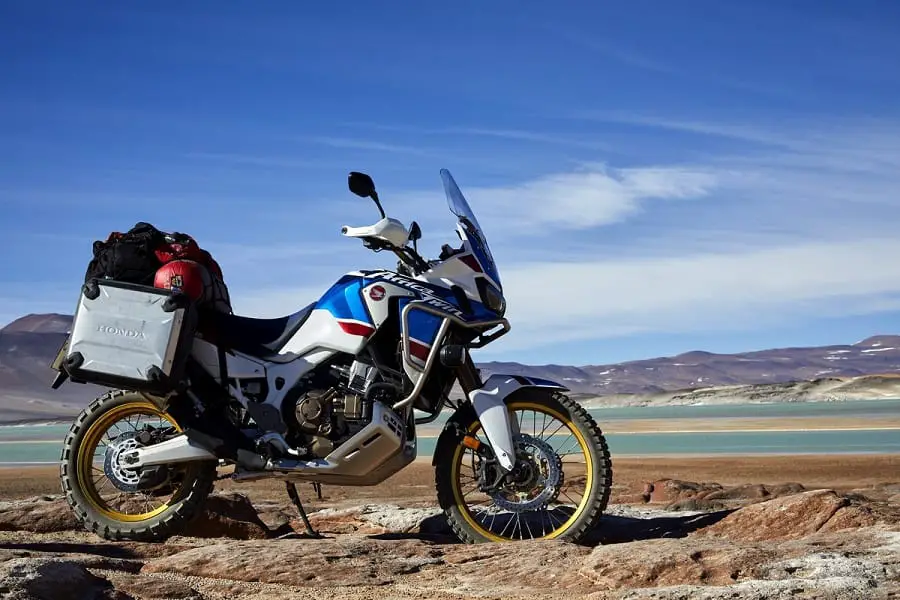
Hard luggage
There is just something about a big GS Adventure with aluminium cases that wants you to sell everything and ride around the world.
A hard luggage system consists of pannier boxes that attached to a special mounting rack. The rack is bolted onto the frame of your bike and the panniers are usually quickly detachable from the rack. Most boxes can be fastened securely onto the rack from inside the lockable box so that it cannot be removed without the key.
An optional third pannier, or top box, can be mounted on top of the luggage rack for additional luggage space. There are many pro’s and con’s to hard luggage. Let’s start with the positives.
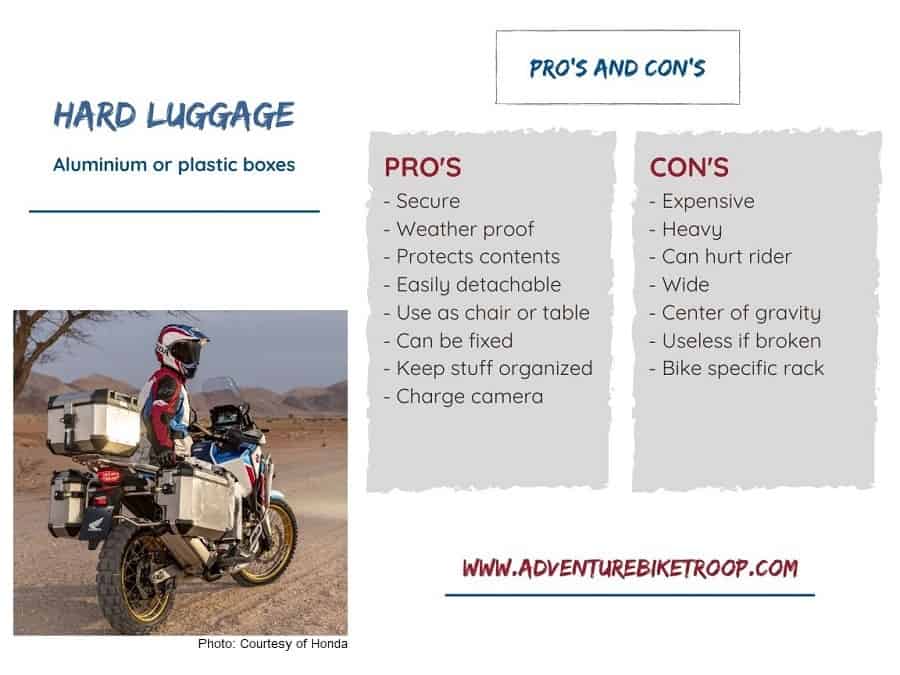
We like:
Hard luggage is secure:
Probably the number one thing that I like about hard luggage is the fact that you are able to lock your valuable items inside when you leave your bike. Most hard luggage boxes attached to the luggage rack with a locking mechanism inside the lockable box. That prevents miscreants from removing the box without your permission.
Whether you need the added security will depend on where you travel. If you are riding through big cities where you will have to leave your bike in the street if you go into a restaurant or motel, it is a huge advantage. At border posts in developing countries, you need to leave your bike, often for hours, to get the paperwork done. You can’t just remove all your luggage and carry it with you. Being able to lock your equipment can save you a lot of misfortune.
Hard luggage is 100% weather proof
There is nothing worse than drenched underwear after a long day of riding in the rain. Oh wait, there is! A wet sleeping bag. Hard luggage boxes are totally weather proof. This is very useful to keep your camera and laptop dry too.
During a trip through Uganda we rode through torrential rain after crossing the border from Rwanda. That evening I had to hang out my passport and make sure the pages are not stuck together before it dries. We used soft luggage and had to cover our bags with waterproof covers each time it rained. Not having a totally waterproof area on the bike was annoying.
Equipment are protected inside
Dropping your adventure bike at least once on a long motorcycle trip is inevitable. With hard luggage your camera, laptop or camp stove won’t get crushed by the bike’s frame if it falls onto it. Using soft luggage on our 90-day cross-continental motorcycle trip through Africa, we had to carry a DSLR camera and a small laptop in a backpack to keep it safe in case of a fall.
Panniers are easy to remove
Most hard luggage boxes have quick-release systems that make them easy to detach from the rack that is bolted to the sub-frame. All you need is the key to get to the inside of the boxes.
A hard pannier can double-up as chair or table
Hard luggage can be used as a camping chair or a table top. Or you can simply sit on the ground next to the fire like a proper adventure biker. A hard box can be used under the right-hand side of a bike with no center stand in order to lube the chain.
Aluminium boxes can be fixed (sometimes)
Depending on the damage, dents in aluminium hard luggage boxes can be removed from the inside with a hammer (or large rock if you have to). A torn box can be brazed my a bush mechanic if you can find one. Plastic boxes may not be fixable if it is wrecked in a crash.
Organize your gadgets
Due to the fact that hard luggage has a fixed space inside, it is easier to compartmentalize and organize your tools, camping equipment and gadgets inside. It is very useful to insert inner bags that you can simply pull out as required. Each time you are done with something, it is easy to put it back in its spot. With soft luggage, rummaging around inside to find your toothbrush can be a pain and there is nothing worse than a burst shampoo bottle between your clothes. You do wash your hair on a bike trip, right?
Charge camera and laptop while riding
By installing an inverter inside one of the hard luggage boxes, you can charge your cell phone, camera or laptop battery while you ride without worrying about it getting dirty, wet or damaged outside or in a tank bag. It is also out of the way of prying eyes when you stop. This way, you can keep your devices charged while you ride, ready to update your blog when you stop for the night.
We don’t like:
Hard luggage is expensive
Hard luggage from known brands like Zega or Givi are expensive. You are looking at anywhere between $1 250 and $2 000 for a set of aluminium panniers, mounting rack and a top box (if you are lucky). That’s more than what I sold my KLR 650 for.
If you’ve just spent $20 000 on a new adventure bike, what’s a few extra thou? At least the list of pro’s are long. But if money is holding you back from taking your dual sport on a cross country road-trip, forget about the hard luggage and swing your backpack over your shoulder.
Hard luggage is heavy
Hard luggage pannier cases can weight around 10 lbs each. If you add the weight of the luggage rack, you’re looking at anywhere between 30 and 40 lbs just for your luggage system. This puts additional strain on your motorcycle’s rear sub-frame. Luckily, modern large adventure bikes are designed to take the extra weight. The sub-frame on a smaller dual sport bikes might need bracing if you want to add hard luggage full of gear.
Dangerous in a fall
If you are lucky and can anticipate coming off your bike, you may have enough time to plan your landing. With a large hard luggage box in the way, it is quite possible to get your leg stuck underneath the box. This will mean that you are pinned under the weight of the bike.
Taking the full impact of the crash through the small area of a sharp corner of the pannier box can snap a bone. Some boxes are slanted in the front to lower the probability of that happening. I’ve heard of some unfortunate injuries caused by hard luggage falling onto the riders foot or ankle.
Hard luggage is wide
You are unlikely to ride your big adventure big with a full hard luggage system on a narrow single track through a forest. You may, however, traverse a dry riverbed where a wide box can catch on a protruding rock or tree root.
Hitting a solid object with a box that is rigidly fixed to the bike frame will immediately send you off course and possibly result in a crash. Soft luggage will simply deform or tear. Damaged luggage is better than a damaged bike.
Changing the center of gravity
The center of gravity is very important on a heavy adventure bike. We all know it has to be low. And concentrating the weight between the wheels makes the bike easier to handle.
Hard luggage sits high and right on the back-end of the bike. This is probably the worst place to position the bulk of the weight. With a heavy rear end the steering will be less direct and the rear suspension will work overtime. The changes to the dynamics of your bike should be taken into consideration when you decide on how fast to go on a gravel road.
Practice your riding skills with the full weight of your hard luggage before you leave on a long trip.
Damage in a crash
While good quality hard luggage is very durable and designed to withstand the impact of a crash, they are not indestructible. If the attachment point breaks off or the lid cracks open, there might not be anything you can do to fix it. The lid of a bent box might also not be waterproof any longer.
Bike rack specific
Hard luggage boxes cannot be mounted directly to the bike frame. You need to bolt on a specific mounting frame first. These may be bike-specific, so make sure before you buy.
If you are lucky enough to have multiple bikes, you may require different mounting racks, but the boxes should fit both racks of the same brand.
Soft luggage
The most common type of soft luggage consists of heavy duty nylon saddlebags that swing over the pillion seat. The two bags then hang on either side against the side covers, or against a luggage rack. There are many difference brands and types of soft luggage, and they vary greatly in shape, size and price.
We’ve extensively used soft luggage in Africa on many different motorcycles, big and small. They are extremely versatile and have many benefits. Here they are:
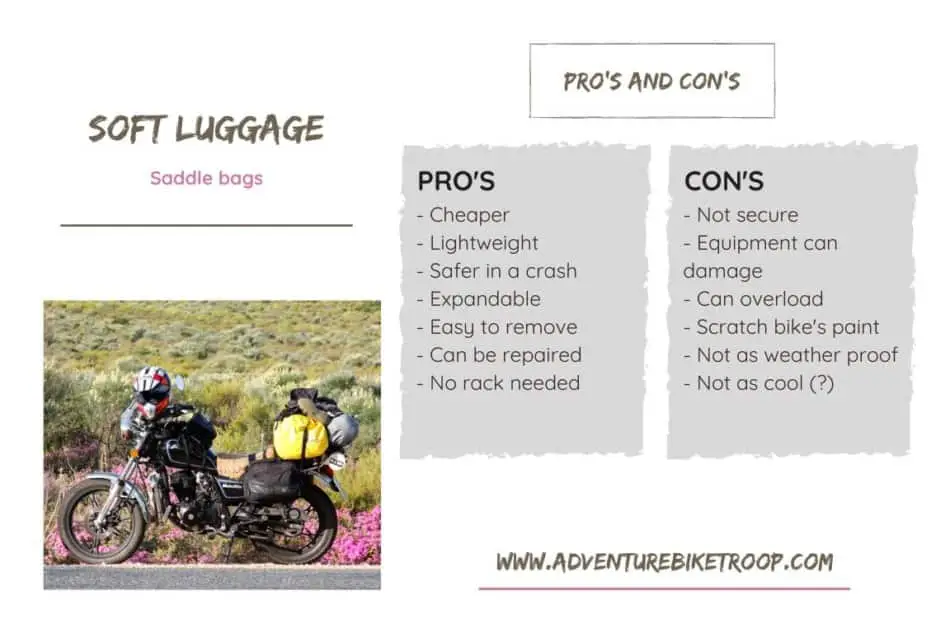
We like:
Soft luggage is cheaper
One of the biggest draw cards of soft luggage systems is that they are much cheaper than hard luggage. You also don’t have to buy a luggage rack. You can pay anywhere from $150 for a set of Oxford panniers to more than $700 for the Mosko Moto Reckless 80. The most expensive set of soft luggage is still cheaper than the cheapest hard luggage.
Soft luggage weighs less
The light weight of soft luggage is a massive advantage over hard luggage. Empty, it weights much less than aluminium panniers with a rack. It sits close to the frame and therefore do not mess up the center of gravity as much. Soft luggage can be used on small motorcycles, as well as large liter adventure bikes.
Battling a big adventure bike in sand or over technical terrain is already a challenge without worrying about large luggage boxes on the back. Every ounce you save in weight will make the ride more enjoyable. The smaller the soft luggage bags, the less likely you are to overload your bike.
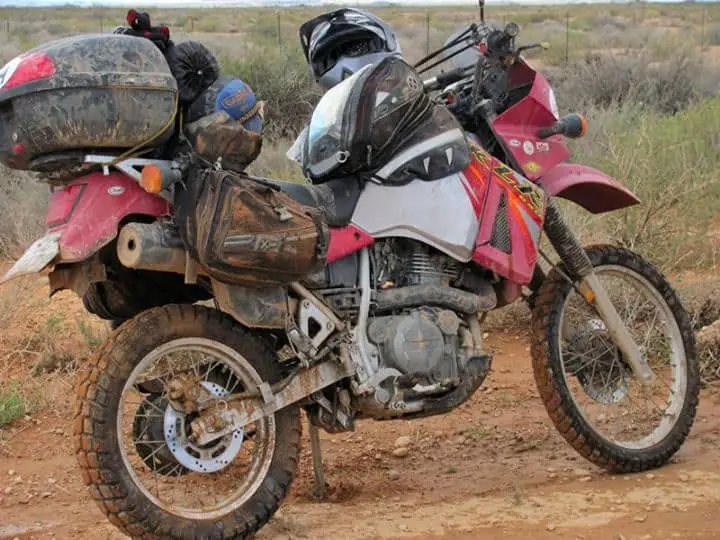
Soft luggage won’t hurt the rider or the bike’s sub-frame
If you come off your bike, soft luggage won’t dig into your ankle or leg the way a hard pannier might. Because soft luggage is more compact and flexible, it is easier for the rider to clear in the event of bailing out during a fall. The impact on the bike’s sub-frame will also be much less severe since the bags will deform and absorb the impact of the crash.
I’ve read stories of riders hitting something with both hard and soft luggage. In the case of soft luggage, the bags simply tore off or got damaged. With the hard luggage, it invariably results a crash as the boxes are rigidly attached to the bike frame.
Soft luggage is expandable
Most soft luggage can be adjusted to some extent. If it is empty, you can draw the straps in to snug up the contents. If you need more space, some bags can extend by unzipping a mid-section. This makes soft luggage more versatile than hard luggage. Whether you are going on an overnight ride or a month long tour, you only use the space you need.
Easy to remove
Most soft luggage can easily be removed by undoing the straps from the bike frame or rear luggage rack. In many African countries we were not able to camp and therefore had to leave our bikes on the street. With soft luggage, it was simple to remove it and carry it up to our room with us.
We’ve used our pannier bags on many different bikes and it is simply a matter of: 1) throw it over the saddle, and 2) attached the straps and tighten it.
Can be repaired or strapped to the bike if damaged
In the event that you do damage your luggage on a long trip, soft luggage can generally be repaired anywhere in the world. Apart from having it stitched up, you could even duct-tape it in a pinch. Depending on the damage, fastening it with a cargo net or extra strap will get you home without losing your gear. With hard luggage, you might be stuffed if a mounting point cracks.
No need for custom rack
Soft luggage can be used over a luggage rack to avoid scratching your shiny new adventure bike’s side covers, but you don’t have to. You can simply swing it over the rear seat and be off. The added benefit is that you can use it on multiple motorcycles if you are lucky to have a big garage.
To see how to fit all your camping gear and tools for a round-the-world adventure bike trip into soft luggage, check out how RTW-Paul packs his Mosko Moto soft luggage on his KTM 500 EXC below:
We don’t like:
Before you click ‘Add to Cart‘ on these great value-for-money Wild Heart waterproof saddlebags at Amazon, read the Con’s list below.
Soft luggage is not secure
Soft luggage cannot be locked like hard luggage cases. This can be annoying if you are traveling through busy cities or developing countries where villages are often crowded. By that I don’t mean there are more criminals, but opportunistic pick-pockets are everywhere.
When we traveled through Africa for 3 months we used soft luggage and did not have any problems at all. We did, however, either camp next to our bikes or remove the saddle bags and carried it into our dorm rooms.
At border posts, both of us had to enter the customs and immigration offices, which meant the bikes were left unattended among a lot of bystanders. We simply trusted the lone policeman to look out for out belongings. I am glad to report we never lost anything.
On a side-note. Someone did steel my socket set. I was so disappointed when I realized this when I wanted to service my bike in Rwanda. Then I remembered, I moved it to my tank bag after the last service. Silly me!
For extra peace of mind, you can get a lockable tie-down strap like this one. While this may deter a passing Mr. Long Fingers, a more devious thieve can simply open the side of the bag with a cheap pocket knife.
The contents will absorb the impact of a fall
If you crash or your bike falls over onto your soft luggage, the contents will cushion the fall. That means you cannot safety store your laptop or camera inside without risking damage. It is perfect for clothing, tools and other gear that will not be bent or broken if you drop the bike on it.
Luckily, most soft luggage sits rather high and close to the frame, so a low speed tumble should not be too serious. I’ve dropped my bike in mud many times without any damage to my Oxford pannier bags or the stuff inside.
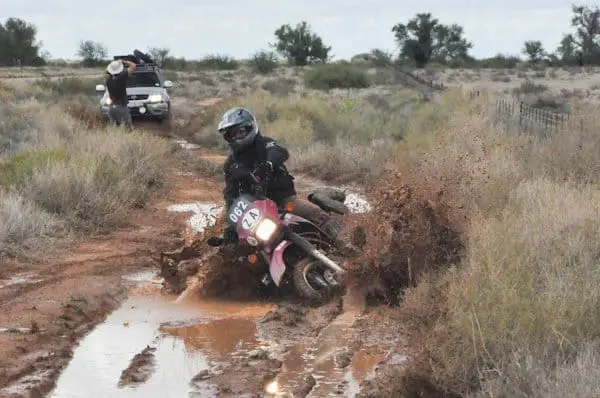
There is a temptation to overload soft luggage
With hard luggage the space you have available is fixed. Unless you load it with only heavy tools, or bricks, you won’t easily overload it. They are sturdy and designed to carry whatever you can fit inside.
With soft luggage there is the temptation to push your luck and squeeze in that one last thing. If you’ve already expanded the volume and packed it so full that the zip only just closes, there is a risk that it may tear at a seam somewhere. This is less of an issue on the more expensive brands. If you buy the cheapest bags you can find, rather leave that hammer (for the tent pegs) at home and use a rock lying around in camp.
Soft luggage may damage the bike’s paintwork
On an old dual sport, the side covers are probably already faded from the sun and full of Fox stickers. On a brand new adventure bike, soft luggage may scratch the shiny side panels on some models. This can be avoided by fitting a luggage rack similar to the ones used for hard luggage.
Soft luggage may be less weatherproof
This one may be somewhat unfair. Most soft luggage has some type of weather proofing. The Mosko Moto Reckless 80 has a 25 liter dry bag that fits inside the side panniers. These are 100% waterproof and can easily be removed. Our Oxfords have rain covers than pull over the outside and we’ve ridden in rain for days on end without the contents getting wet.
The only reason why this is listed under the disadvantages is because if you don’t close it properly or if the wind lifts the rain cover slightly, some water can get in without you noticing. With hard luggage this is just not a problem.
Soft luggage does not look as cool as hard luggage
This one is even more unfair than the previous point which goes to show that soft luggage is hard to fault. This truly is a subjective thing, but some riders immediately think of a GS with aluminium panniers when someone mentions “Round The World bike trip”.
Then you get out there in the real world and see people riding DR’s, XT’s and XR’s with saddle bags dangling on each side. The picture below was taken in Sudan after two months in the saddle of my Chinese delivery bike. I think it looks kinda cool.

Other luggage types for dual sport riding
I’ve seen many ways riders use to carry their stuff around. Some are safer than others. On the first two-up trip with my wife, I welded a small rack to fit the back of my KLR 650 C-model (I am not a welder). We simply strapped a normal travel bag to it. Although we slept hard that night, we managed fine on some gnarly dirt roads.
On this very trip, a guy at a local roadside cafe told us about a couple who died when their luggage came loose and got stuck in the rear sprocket, sending them off the road. After that story, I’ve always paid close attention to what, and how, I carry luggage on my bike.
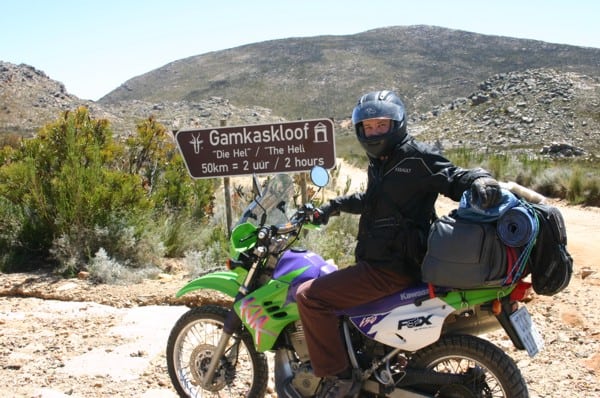
On a week long trip into the arid regions of Southern Africa, a group of friends and our wives rode a couple of XT 500’s and a KLR 650. My buddies can weld much better than I can and decided to fashion their own DIY luggage racks.
The one fitted a top box on each side with a ammo box on top. The other guy strapped two plastic ammo crates on top of each other. The luggage racks on both bikes broke during the trip. Luckily my wife drove behind us in a 1984 Suzuki SJ413 as a back-up vehicle.
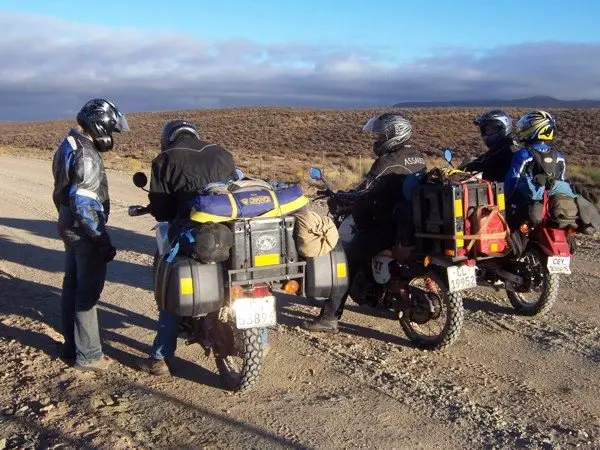
Tank bag
Regardless of whether you use hard luggage or soft luggage, a tank bag is a must. It fits on any bike and it is very convenient for your cell phone, map, camera and other gadgets that you want close at hand.
Roll-top dry bag
On our Crossing Africa trip, we used dry bags from Touratech, similar to the ones Charlie Boorman and Ewan McGregor used on their Long Way Down trip. That was the first thing Charlie noticed when we ran into him in Divundu in Namibia. The bags are super durable and 100% waterproof. Of all the gear we carried, I was most impressed by these bags which kept our clothes and sleeping bags dry.
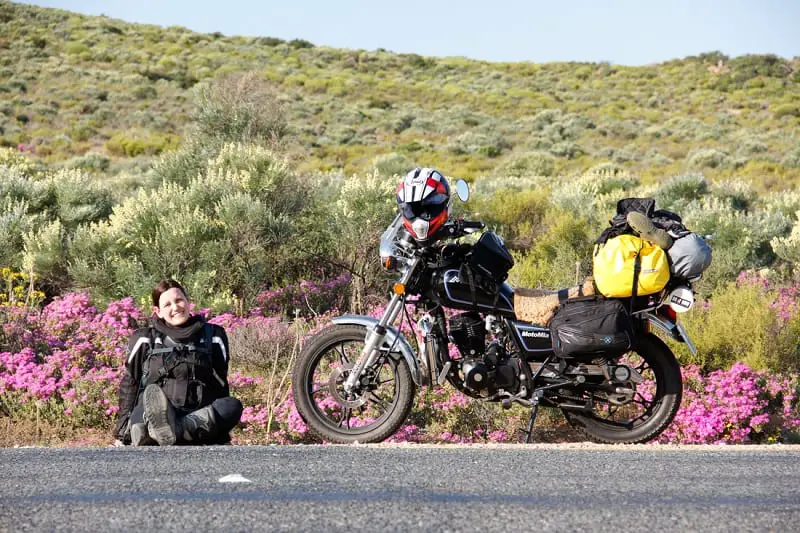
PVC drain pipe
Instead of a tool tube kit, you can buy a piece of PVC drain pipe and glue the one end shut with a stopper. At the other end, glue on a threaded opening and you’ve got the perfect storage for two spare tubes and a light rain jacket for easy access. I fitted ours to the under side of the rear luggage rack with heavy duty zip-ties.
Backpack
Due to taking soft luggage on our 90-day African bike trip, the safest place for our DSLR camera and laptop was in our backpacks. As uncomfortable as it sounds, I become so used to riding with a backpack on my back and a Camelbak for hydration on the front that I almost felt naked without it.
It was also nice knowing that the most valuable items were always with me and could not be forgotten on the bike.
Final thoughts
While hard luggage has clear advantages when it comes to security and keeping the contents safe in a fall, I personally prefer soft luggage for the reasons above.
There are so many motorcycle luggage options available and my best advice is to keep it as light as possible. Not only is it safer and easier to ride, but you’ve not less worries and you’ll enjoy yourself much more.
If in doubt, leave it at home.
